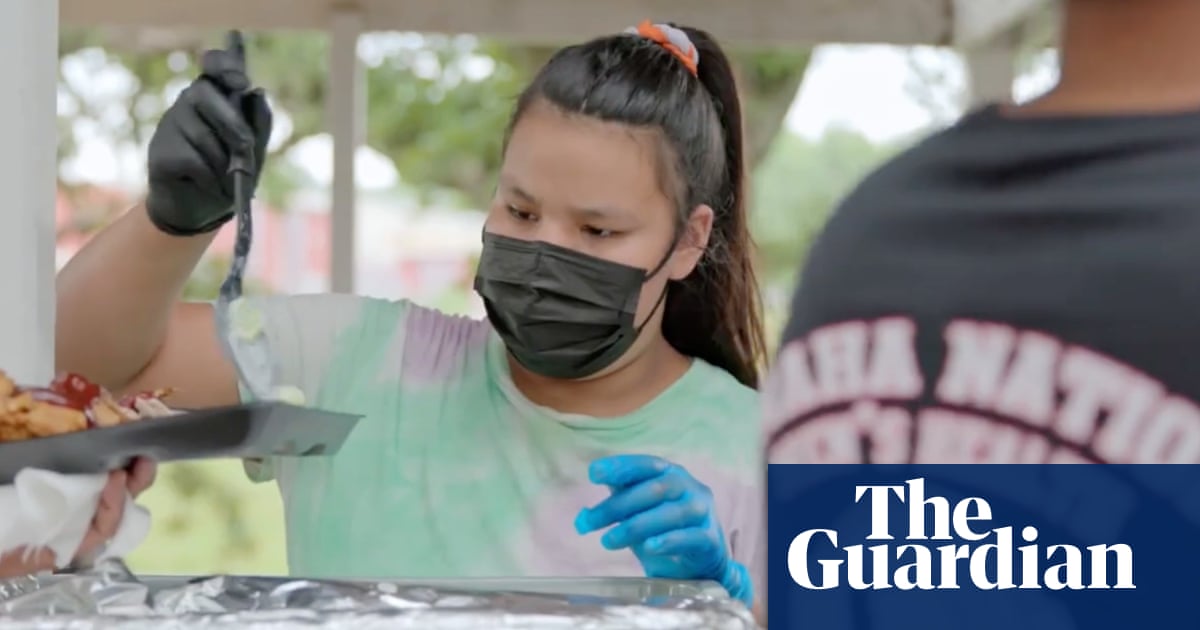‘Hey, I grew that’: the Native American school that’s decolonizing foodways | Native Americans


Before joining her school’s gardening program this year, 14-year-old Emilie Lyons had never encountered an eggplant. She is a freshman at Umoⁿhoⁿ Nation public school, which serves more than 600 students on the Omaha reservation in Macy, Nebraska. When she brought the vegetable home, she and her dad looked up recipes for how to prepare the peculiar purple nightshade and were surprised by how tasty it was.
Umoⁿhoⁿ Nation is just one Indigenous-focused school across the US where administrators and educators are endeavoring to introduce healthy, culturally relevant foods into their lunches and other culinary initiatives.
Though each program is unique, they have similar objectives: to help kids reconnect with their heritage; to strengthen tribal sovereignty; and to combat the marked health disparities and disproportionate food insecurity – estimated at nearly 24% – affecting tribal communities in the aftermath of colonialism. Around 68% of Native American children qualify for free lunches, meaning these may be the most reliable and nutritionally balanced meals they eat.
Macy is considered a food desert, with no grocery store and just a gas station serving the north-eastern Nebraska town of approximately 1,000 residents. The village also has some of the highest poverty and unemployment rates in the state. To address these overlapping issues, Umoⁿhoⁿ Nation’s farm-to-school initiative began as a state-funded Jobs for America’s Graduates (JAG) program, designed to equip youth with employable skills and improve their success in education and their future careers. It was the students’ idea to develop a community garden where they’d log their work hours.
Three years in, the summertime program employs about 50 teens, who grow and harvest more than 25,000 plants each season, including cucumbers, peppers, tomatoes, onions, sunflowers, pumpkins, beans, corn, squash and, yes, eggplant. They prepare and preserve that produce in the school’s culinary department to be served in the cafeteria’s fresh salad bar, sold at the local farmers’ market or dished up at a new cafe in town (Macy’s first). There’s also an outdoor classroom on campus, where naturalists, elders and other knowledge keepers impart traditional Indigenous knowledge.
“This was my first experience gardening,” said Lyons. “At first, I did it for the money, but I actually really enjoyed doing the activities with my friends. It was a very powerful experience to plant a seed, care for it, watch it grow, then put these food products up at the farmers’ market. When my friends and I walk by the salad bar in the cafeteria, I’ll point something out to them and say: ‘Hey, I grew that in the garden.’”
In addition to developing concrete skills and earning $10 an hour working four-hour shifts, program participants are learning important life lessons. “We have noticed a difference even in how the kids carry themselves. They’re so proud of what they’ve done,” said the Umoⁿhoⁿ Nation superintendent, Stacie Hardy. “They feel connected to the school and the community, and they’re giving back to their elders. They are also developing these strong leadership and communication skills. I never could have envisioned the impact this would have on our district.”
The project’s success is largely thanks to the farm-to-school director, Suzi French, who oversees the 14,000-square-foot garden alongside JAG career specialist Ricardo Ariza. To secure the land, he worked out an agreement with the Omaha tribal council to lease 7 acres near the school for $1 per acre each year. Throughout the summer, French teaches the children not only how to care for the crops but also how to identify and forage for wild plants including chokecherries, gooseberries, mulberries and wild grapes.
“We are building farmers,” said French. “For most of these kids, this is their first job. They come to work on time. They turn off their phones. They smile and laugh. They get to just be kids for a few hours. It’s a real eye-opener for them when they get to eat what they grew and share it with the community.” That includes lunches for program participants and elders during the summer and early fall, as well as a community meal for 500 people at the annual harvest powwow.
All that activity is improving the kids’ health, too. With measurements taken at the start and end of the work season, participants saw an improvement in weight, the body mass index (BMI) height-weight scale, blood pressure and A1C levels, which measure blood sugar over time. Plus absenteeism, an issue at tribal schools, is down at Umoⁿhoⁿ Nation.
Though the farm-to-school project operated at a deficit this year, administrators have been successful in securing ongoing financing through not only the Nebraska department of labor but also the state’s vocational rehabilitation program and several foundations. The Nebraska fresh fruit and vegetable program also allows the school to purchase produce from the garden at the standard local vendor rate, meaning that money stays within the district.
These accomplishments have come with their fair share of obstacles. The well they dug the second year went dry in the third, requiring the teens to haul buckets in the summer heat to water the crops. There are also on-the-job problems such as dehydration from working in the heat, bee stings and the like. But the major hurdle is getting kids the right documentation to start in the JAG program.
“One of the biggest challenges is that a lot of our kids don’t have a birth certificate on file, a social security card or a bank account – all of which they need to be a department of labor employee,” said Hardy. “Many of them are raised by grandmas or great-grandmas or they couch surf from place to place, so those documents can be hard to keep track of. As a school district, we help the students get all that set up. Then on payday, we load up the school bus and take them to the bank to cash their paychecks.”
Umoⁿhoⁿ Nation serves as a strong model for other tribal schools eager to decolonize their culinary offerings, with administrators and food service directors regularly visiting to learn about best practices. But many institutions are far from establishing such a robust program.
“Most schools are trying to get just one traditional ingredient added into their lunch program,” explained Richard Elm-Hill, a member of the Oneida Nation of Wisconsin. As the senior program officer for the First Nations Development Institute’s Nourishing Native Foods & Health program, Elm-Hill oversees the nonprofit’s Native Farm to School project. He explains that institutions often face uphill battles, which vary greatly depending on school type, state and tribal regulations, and more.
“For example, if you want to incorporate traditional corn into the lunch program, you need to source it from a producer who grows it and processes it a certain way, usually at a [US Department of Agriculture]- or state-certified facility, plus that producer needs to be able to supply a large-enough quantity,” he said, noting that this often creates hurdles for small Native producers. “But there are other opportunities beyond the meal program where you don’t have to jump through all those hoops to give kids access to traditional foods, like after-school programs and sporting events.”
“Price point and sourcing tend to be some of the biggest obstacles,” added Mariah Gladstone, an Indigenous food sovereignty expert and a descendant of the Blackfeet Tribe of the Blackfeet Indian Reservation of Montana and an enrolled member of the Cherokee Nation of Oklahoma. Gladstone developed the online platform Indigikitchen to foster an appreciation for traditional foods. The federal governing body outlines how specific ingredients count toward meal-pattern requirements in child nutrition programs, a process called crediting.
“There can also be a question of how to credit foods to ensure all the essential meal components are covered. For instance, how do you credit stinging nettle greens – a leafy green you can use just like spinach – since they are not outlined in the USDA crediting guidelines?”
To help address this, Gladstone developed a school toolkit in collaboration with No Kid Hungry Montana. It outlines how to identify, procure and incorporate traditional ingredients such as bison, fish, berries and root vegetables into school offerings. Though it is largely focused on Great Plains foods, the guide can help food service directors across the country navigate USDA crediting. Gladstone has helped implement the toolkit within the region, like at South Dakota’s Cheyenne River schools, where they recently added bison into their meals.
Oglala Lakota Sioux chef Sean Sherman – a leader in the movement to revitalize Indigenous foodways with his renowned Minneapolis restaurant, Owamni, and his nonprofit Natifs – is developing a similar resource for Red Cloud Indian School in South Dakota. A former boarding school, the private Catholic institution serves nearly 500 students on the Pine Ridge reservation, where Sherman grew up subsisting mainly on a diet of government commodity foods (though he did not attend Red Cloud). The area is known for having some of the highest poverty rates in the US and lowest life expectancies in the world.
In addition to advising on properly equipping the Red Cloud kitchen, Sherman and his team created kid-friendly recipes that eschew Eurocentric ingredients – reflecting his decolonized cuisine philosophy – yet remain relatively affordable and simple to prepare. Meals include turkey tamale pie with maple squash purée; bison meatloaf with cranberry wojapi sauce and wild rice, mashed sweet potatoes and corn and peppers; and turkey-and-bean chili with gluten-free, dairy-free cornbread. “We can’t just hand over Owamni recipes, which are a bit more experimental,” Sherman said with a laugh. “We don’t want to scare the kids.”
He hopes his impact reaches far beyond Red Cloud, which is why he’s establishing a wholesale side of his business to help connect tribal schools and similar organizations directly with Native producers.
“The need is too great, so we can’t just work with one school at a time,” Sherman said. “Because we can order in bulk, we can keep prices low and act as a centralized distribution point for getting food products like corn, beans and rice out there. As we develop more Indigenous Food Labs in the future, those can also serve as regional distribution points.”
Across the country, several schools have made impressive strides in incorporating Native ingredients into their culinary offerings. In Washington state, Seattle World School serves students salmon caught by the Muckleshoot Indian Tribe. Utah’s state school system sources meat from tribal-owned Ute Bison. In Hawaii, where nearly 90% of food is imported, the Māla‘ai Kula Kaua‘i Farm-to-School project connects children with traditional ingredients like kalo (taro), uala (sweet potato) and ulu (breadfruit) via school gardens and meals. These initiatives are supported by organizations such as the First Nations Development Institute, the Intertribal Agriculture Council, the National Farm to School Network, and the USDA’s farm-to-school program.
The benefits of these efforts cannot be overstated, extending far beyond personal health to encompass Indigenous sovereignty and self-determination. “Our cultural foodways, kinship ways and educational frameworks were removed by design – but we can put them back by design,” said Elm-Hill. “When I look at our younger generations, I see a lot of shattered pieces that we’re trying to put back together. It would be different if from a young age, students were eating traditional meals, but they might be trying their own foods for the first time at age 16. Their taste buds have changed, but they can redevelop a taste for their traditional foods.”
This purposeful movement also prompts a larger discussion about a necessary paradigm shift within US school lunch programs as a whole. “The chicken nuggets-based school lunch model is not benefiting kids or producers, and we need to shift away from that across the board,” said Gladstone. “This cookie-cutter template of thaw-and-heat meals just has not worked. There’s a lot of work to be done to bring real food back into school lunches, but I’m really hopeful for what the future holds.”
At Umoⁿhoⁿ Nation in Nebraska, school leaders intend to keep growing their farm-to-school initiative. They have plans to dig a deeper well and incorporate a drip-line irrigation system. They will add greenhouses to extend the growing season, develop a better-equipped processing center, open a larger onsite community market and perhaps even start a small-scale livestock program. From there, Hardy dreams that one day they’ll be able to supply fresh produce to the local senior center, the hospital or even nearby school districts.
Financing those ambitions requires extensive effort on the part of Hardy’s team. For instance, this year’s farm-to-school costs – encompassing equipment, salaries and fringe benefits – totaled nearly $320,000, while funding from government and donor sources came in around $120,000, resulting in a budget shortfall. (To date, the school district has covered the deficit with its general operating funds.) Hardy isn’t discouraged.
“These new developments won’t happen as quickly as we want them to, but we’ll find donors or grant funding to make it happen,” she said. “The more people hear about our project, the more they want to offer support. We have a great group of people working on this, and we’re dedicated to figuring it out.”
Driving that steadfast determination is the program’s obvious impact on students, elders, community members and even bigger-picture tribal sovereignty. “I have been working in community food for a very long time, and one of my goals was to bring Indian corn back into our community,” said French, reflecting on the initiative’s accomplishments. “That was our most important food source 100 years ago, but over time it became so expensive that it is only used for ceremonial purposes today. This year, we planted and hand-harvested three acres of traditional corn and processed more than 400 quarts of it, so our students and community have access to it once again.”
For 14-year-old Emilie Lyons, the farm-to-school program has sparked an interest in home cooking, taught her invaluable life lessons and helped rekindle a deeper connection to her heritage. “It’s an essential life skill to know how to cook at home with your own ingredients,” she said. “It’s really fun to get to know yourself, what you like and don’t like, by preparing dishes you didn’t even know about. That’s so important because there are so many processed foods around us that aren’t good for my people. It really gives me comfort to know that we’re trying to give our people better food.”
Bison meatloaf with cranberry wojapi sauce and wild rice
Prep 40 min
Cook 60-75 min
Serves 6
1lb ground bison
1 cup cornmeal, fine or medium grind
2 eggs
1 14.5-oz can diced tomatoes, drained
1 onion, peeled and diced
1 bell pepper, stemmed, seeded and diced
1 carrot, diced
¾ cup cranberries, minced (fresh or frozen)
2 tbsp garlic, minced
1 tbsp pure maple syrup
1 tsp salt (or more to taste)
For the wild rice
1 cup wild rice
3½ cups water
For the cranberry sauce
1 cup cranberries (fresh or frozen)
½ cup water (plus more if sauce is too thick)
¼ tsp salt
Bring water to a boil. Stir in wild rice, reduce heat to simmer, cover, and stir occasionally for 30 to 35 minutes, or until kernels begin to puff open. Uncover, fluff with fork, and cook an additional 5 minutes. Drain excess water if necessary.
While rice is cooking, combine all cranberry sauce ingredients in a large pot and bring to a boil. Simmer for 20 minutes, adding water as necessary. Using an immersion blender, regular blender or food processor, blend until smooth. Adjust water as necessary for desired consistency.
Preheat oven to 375F (190C). Lightly coat a large loaf pan with vegetable oil.
In a very large mixing bowl, combine meatloaf ingredients. Mix until just combined, being careful not to overmix. Transfer mixture to oiled loaf pan. Spread cranberry sauce over top of meatloaf.
Place meatloaf pan on a sheet pan covered in parchment paper to catch any juices that bubble over. Bake in preheated oven for 60 to 75 minutes, until internal temperature reaches 160F (70C). Baking times may vary; always check internal temperature to ensure doneness.
Once done, remove from oven and let rest for 15 to 20 minutes to allow juices to redistribute. Slice and serve with wild rice.
Source link




